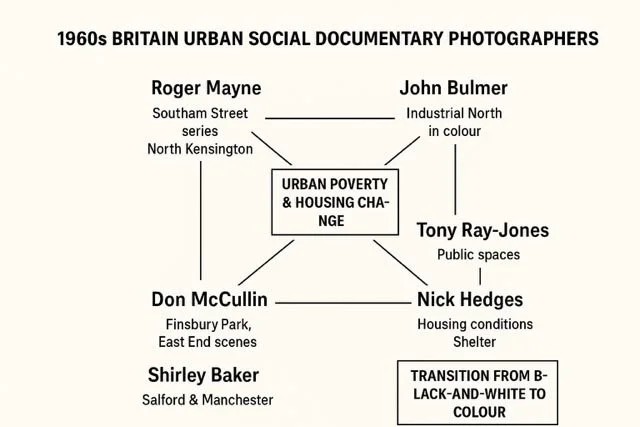In 1960s Britain, urban social documentary photography was shaped by a small but influential group who turned their lenses on working-class communities, inner-city life, and the social changes of the post-war period.
Here are the key figures:
⸻
1. Roger Mayne
• Best known for his Southam Street series (1956–1961).
• Captured children, teenagers, and street life in North Kensington before redevelopment.
• His style combined candid observation with modernist composition.
⸻
2. Don McCullin
• Although later famous for war photography, in the early 1960s he produced powerful images of London’s working-class communities, especially in Finsbury Park and the East End.
• His portraits of unemployed men, gang members, and inner-city poverty revealed a raw social realism.
⸻
3. John Bulmer
• One of the pioneers of using colour in British documentary work at a time when black-and-white dominated.
• Photographed industrial towns in the North of England for magazines like The Sunday Times.
• His colour work gave warmth and nuance to scenes of hardship.
⸻
4. Shirley Baker
• Documented the streets of Salford and Manchester during the clearance of terraced housing.
• Her compassionate images focused on children playing among rubble and adults maintaining community life amid demolition.
⸻
5. Nick Hedges
• Commissioned by the housing charity Shelter in the late 1960s to document poor housing conditions.
• His photographs were used in campaigns to highlight urban deprivation and drive policy change.
⸻
6. Tony Ray-Jones (late 1960s)
• Although more often associated with his wry look at British leisure, his work also captured aspects of social behaviour in public spaces, bridging street and social documentary traditions.
⸻
Common Themes
• Urban poverty and housing change – clearance of slums, new tower blocks, and shifting communities.
• Youth culture and street play – children as symbols of resilience.
• Transition from black-and-white to colour in the late 1960s.
